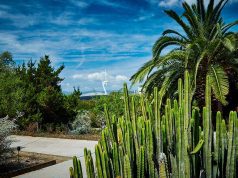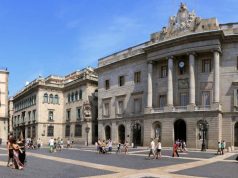Plaça Reial is a historic square just off La Rambla. Full of history, the square transforms in to a top night spot.
If you are looking for a place to enjoy the charm and vitality of Barcelona, you should not miss Plaça Reial, a royal square in the Barri Gòtic (Gothic Quarter) of the city. Plaça Reial is a popular tourist attraction, especially at night, as it hosts many restaurants, bars and some of the city’s most famous nightclubs. It is also a meeting point for locals and visitors during festivals and celebrations, such as La Mercè or New Year’s Eve.
Plaça Reial was built in the 19th century on the site of a former Capuchin convent that was demolished in 1835. The architect Francesc Daniel Molina i Casamajó designed a luxurious square with the aim of honoring the monarchy. In fact, the original plan was to place a statue of King Ferdinand VII in the center of the square, but it never materialized. Instead, a fountain of the Three Graces was erected, surrounded by four palm trees.
Gaudí Lamp Posts Are Still There!
One of the most distinctive features of Plaça Reial are the two streetlamps on both sides of the fountain. They were designed by none other than Antoni Gaudí, the famous Catalan architect who left his mark on many buildings in Barcelona. The streetlamps are decorated with winged helmets and dragons, and they were installed in 1879, when Gaudí was still a young and unknown artist.
The square is also notable for its uniform and elegant buildings with porticoes and terracotta ornaments. They were the home of important Barcelona families, although over time they have been transformed into hotels, restaurants and shops. Some of them still preserve their original names and coats of arms, such as Casa Martí or Casa Bruno Cuadros.
Plaça Reial is a lively and vibrant square that reflects the spirit of Barcelona. It is a place where you can enjoy a meal, a drink, a concert or a dance, or simply admire the beauty and history of its architecture. It is a royal square that welcomes everyone who wants to discover the magic of Barcelona.
A Turbulent History
Plaça Reial has not always been as glamorous and peaceful as it is today. In fact, it has witnessed many changes and conflicts throughout its history. From humble origins as a hub of prostitutes, the square has seen convents open and close, cafés and restaurants spring up as the bourgeoisie rose, social decline and unrest manifest themselves in ugly images, and tourism redeem its reputation.
During the First World War, the square became an asylum for foreign refugees living on alms. During the 1920s and ‘30s, inflation and rising prices caused large workers protests, many of which took place in this square and ended in violence. After the Spanish Civil War, the square definitively lost its bourgeois character; it housed people living in extreme poverty and became synonymous with crime and drug trafficking. Even after the end of the Francoist dictatorship, political and social fractures were exposed within the Plaça Reial. Throughout the 1980s, regular fights broke out between political extremist groups. One of its most dramatic episodes occurred in February 1988, when two rival gangs clashed in the square in a confrontation lasting several hours, using batons, knives and machetes.

A Cultural Hub
Despite its turbulent past, Plaça Reial has also been a cultural hub for Barcelona. It has hosted many artistic events and personalities over the years. For instance, it was here that Pablo Picasso had his first exhibition at Els Quatre Gats café in 1899. It was also here that Joan Miró painted one of his famous murals on the façade of Casa Martí in 1978. And it was here that Freddie Mercury sang “Barcelona” with Montserrat Caballé during La Mercè festival in 1988.
Today, Plaça Reial continues to be a place where culture thrives. It is home to some of Barcelona’s most emblematic nightclubs, such as Sidecar, Jamboree or Karma, where you can enjoy live music and dance until dawn. It is also the venue for many open-air concerts and shows, especially during La Mercè festival in September, when the square becomes a stage for local and international artists. And it is the place where you can find the Pipa Club, a historic and reinvented speakeasy cocktail bar that hosts jazz sessions, poetry readings and cultural events.
Plaça Reial is more than just a square; it is a symbol of Barcelona’s history, culture and diversity. It is a place where you can experience the past and the present, the tradition and the innovation, the elegance and the bohemianism of this amazing city. It is a place where you can feel the royal spirit of Barcelona.













